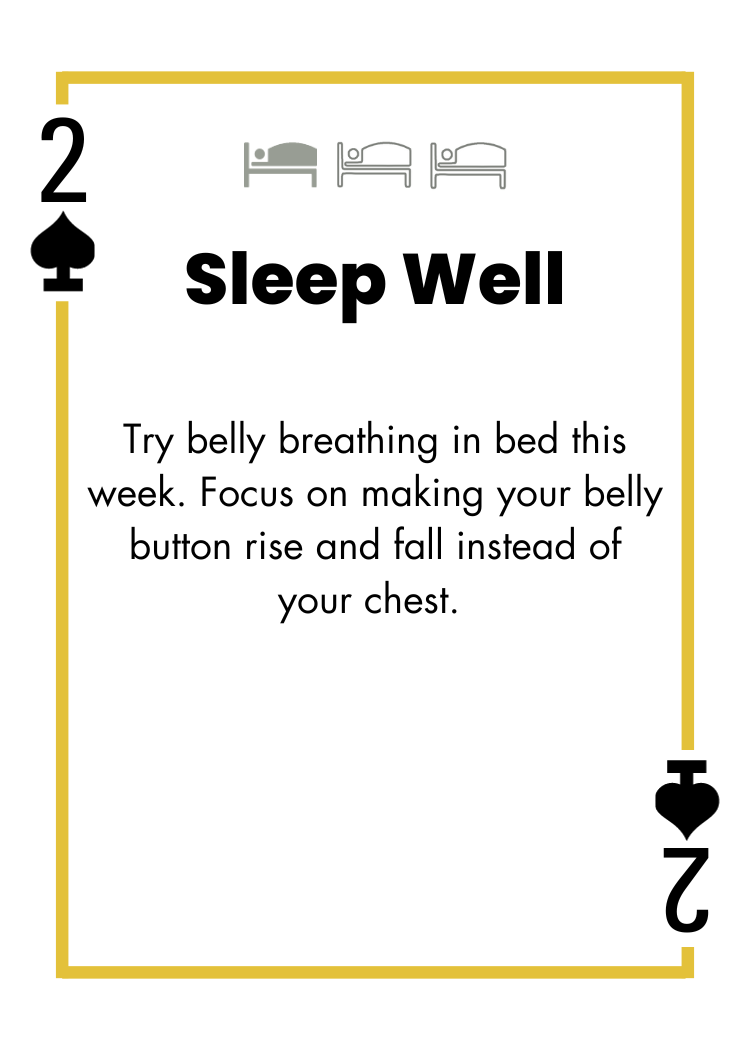2 of Spades - Belly Breathing

Today, you’ll take around twenty thousand breaths. The average human can only survive without breathing for a few minutes. Can you think of anything else we can’t live without for even a few minutes?

It’s safe to say that breathing is crucially important. It is an involuntary process, meaning our body does it automatically without us needing to think about it. However, for the next few minutes, let’s think about it and see what we can learn.
Firstly, let’s break down what breathing is by considering the normal, relaxed breaths we are taking as we read this. The thoracic cavity is what we call the space inside our ribcage that contains our heart and lungs. We have various muscles in our body that work to expand the thoracic cavity. Some of these muscles “lift” the ribcage. When this happens, air can rush into our lungs. Breathe in. When these muscles relax, the ribcage depresses, decreasing the space inside the thoracic cavity, and forcing that air to rush back out. Breathe out.
However, these muscles that move the ribcage are not the only muscles we use to breathe. The diaphragm is a crucially important muscle for breathing. It is a dome-shaped muscle that sits in your abdomen, just below your lungs and heart. When your diaphragm contracts, it pulls away from your lungs, allowing your lungs to expand and fill with air. When your diaphragm relaxes, it presses against your lungs, causing air to flow out of them.
So, what is meant by “belly breathing”?
Belly breathing is a breathing technique that goes by a few names. In the scientific community, we call it diaphragmatic breathing. Belly/diaphragmatic breathing is simply a breathing technique in which we focus on using our diaphragm to breathe instead of our ribcage-moving muscles.
Why does belly breathing help me sleep well?
In 2021, Liu et al. studied the effects of diaphragmatic breathing on the sleep of nurses during the COVID-19 outbreak. If there was ever a group of people who needed some relaxation, this may have been it! Here is what they observed in the nurses who performed the diaphragmatic breathing intervention:
- Improved global sleep quality
- Improved subjective sleep quality
- Reduced sleep latency (they were able to get into deep sleep quicker)
- Less sleep disturbances
- Better habitual sleep efficiency (more time actually sleeping while in bed and less time spent lying in bed awake, comparatively)
- Reduced daytime dysfunction
- Reduced anxiety
All of these changes observed were statistically significant.
If belly breathing can improve the sleep of front-line nurses during a global pandemic, it just might be able to do something for you. Why not give it a shot?
Small changes CAN make a big difference – that’s what the 1% club is all about.
- The best way to learn is to lay down on your back or sit comfortably in a chair.
- Place one hand on your belly, and one hand on your chest.
- Inhale slowly through your nose. As you inhale, focus on letting the air fill your belly. You should feel the hand on your belly rise, but the hand on your chest should remain still.
- Exhale slowly through your mouth. As you exhale, allow your belly to fall.


 See Other Cards!
See Other Cards!